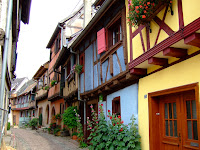 Leaving our 'camping au sauvage' site, we dropped down from the hills behind Munster to the town itself to look at the Munster storks. Apparently some civic soul decided to encourage the storks to the town to act as a tourist attraction. I have no idea why anyone would want to encourage birds to come and deposit their guano all over their beautiful town roofs, for that is exactly what they do.
Leaving our 'camping au sauvage' site, we dropped down from the hills behind Munster to the town itself to look at the Munster storks. Apparently some civic soul decided to encourage the storks to the town to act as a tourist attraction. I have no idea why anyone would want to encourage birds to come and deposit their guano all over their beautiful town roofs, for that is exactly what they do. We picked up the Alsace wine trail again and headed north to Turckheim and then Riquewihr: "one of France's most visited towns"; and it showed. It was far too touristy and we decided that Eguisheim was actually prettier.
We picked up the Alsace wine trail again and headed north to Turckheim and then Riquewihr: "one of France's most visited towns"; and it showed. It was far too touristy and we decided that Eguisheim was actually prettier. After a brief look at Ribeauville, famed for its Riesling, we set off for the Chateau du Haut-Koenigsbourg, a castle, high on a promontory, dominating the valley below. Begun in 1144, destroyed in 1462, rebuilt by the Hapsburgs and burnt down in 1633, the castle was totally restored at the end of the 19th century and is now a precise reconstruction of the original building.
After a brief look at Ribeauville, famed for its Riesling, we set off for the Chateau du Haut-Koenigsbourg, a castle, high on a promontory, dominating the valley below. Begun in 1144, destroyed in 1462, rebuilt by the Hapsburgs and burnt down in 1633, the castle was totally restored at the end of the 19th century and is now a precise reconstruction of the original building. Kaiser William II ordered the restoration, not as a royal residence but as a museum and symbol of the restored empire and German past in Alsace. However, since this area was given to France in the 1918 Treaty of Versailles, it is the French tourist trade that now benefits.
Kaiser William II ordered the restoration, not as a royal residence but as a museum and symbol of the restored empire and German past in Alsace. However, since this area was given to France in the 1918 Treaty of Versailles, it is the French tourist trade that now benefits. It is no wonder that it is the most visited attraction in the Alsace region and is well worth a visit. The views from the castle, almost 750m above the plain, are magnificent; along the Alsace vineyards and across the Rhine to the Black Forest and the Alps.
It is no wonder that it is the most visited attraction in the Alsace region and is well worth a visit. The views from the castle, almost 750m above the plain, are magnificent; along the Alsace vineyards and across the Rhine to the Black Forest and the Alps.It was time to leave Alsace and begin the journey westward. Our destination for the night was Chaumont and the road and villages between the two were totally unremarkable apart from the fact that the roads were very lightly trafficked making for a very easy drive and the fact that we were pulled over by the Gendarmes in a routine check.
 We needed a driver's licence, easily found and then car insurance. I was aware that it was required to carry insurance documentation, so I knew we had it, but where? After a couple of false starts I remembered where it was; produced it; satisfied the Gendarmes; and we were on our way.
We needed a driver's licence, easily found and then car insurance. I was aware that it was required to carry insurance documentation, so I knew we had it, but where? After a couple of false starts I remembered where it was; produced it; satisfied the Gendarmes; and we were on our way.



.JPG)





























 The village was having their annual fete on the green, and the whole place looked like a mocked up tourist attraction.
The village was having their annual fete on the green, and the whole place looked like a mocked up tourist attraction.



